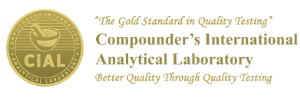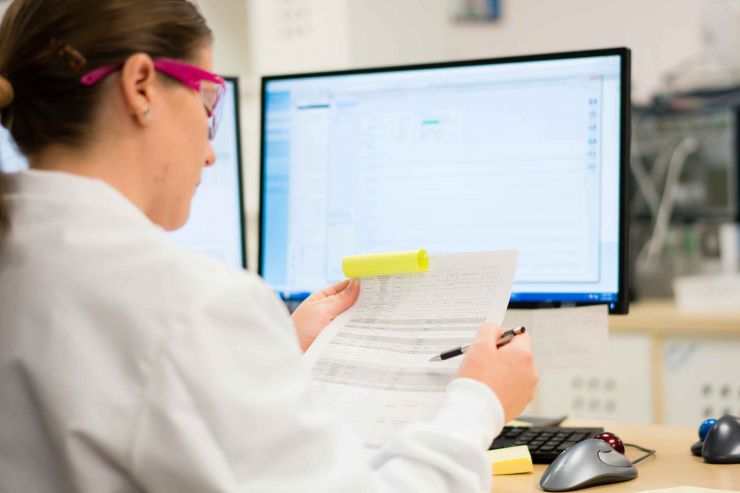USP Guidelines
For the most current USP monograph version, please login here (requires USP-NF account).
Potency Testing
<467> Residual Solvents - Defined as organic volatile chemicals that are used or produced in the manufacturing of drug substances. As these residual solvents do not provide therapeutic benefit, they should be removed, to meet safety-based limits, ingredient and product specifications, good manufacturing practices, or other quality-based requirements.
<541> Titrimetry - A quantitative technique where a solution of known composition containing a reagent is quantitatively added to a defined quantity of a sample solution that contains an unknown amount of analyte. The volume of the titrant consumed by the analyte present in the sample and the known reaction chemistry are used to calculate the amount of analyte.
<621> Chromatography - A separation technique using multistage separation procedures in which the components of a sample are distributed between two phases (stationary and mobile). This technique is useful in qualitative and quantitative analysis of the following; Ultra High Performance Chromatography (UHPLC), Mass Spectroscopy (LC-MS), Gas Chromatography (GC), and Thin Layer Chromatography (TLC).
<659> Packaging and Storage - Provides packaging and storage condition definitions relevant to the storage and distribution of active ingredients and excipients.
<711> Dissolution - Determines compliance with the dissolution requirements for dosage forms such as capsules or tablets, administered orally. Commonly analyzed with the addition of enzymes to Immediate-Release, Extended-Release, or Delayed-Release dosage forms.
<755> Minimum Fill - Ensures that the amount of material filled into the product conforms to the labeled amount. Applies to articles such as creams, gels, lotions, ointments, pastes, powders, aerosols, and sprays packaged in containers.
<795> Nonsterile Compounding - The minimum standards to be followed for nonsterile preparations for humans and animals resulting from excessive microbial contamination, variability from the intended strength of correct ingredients, physical and chemical incompatibilities, chemical and physical contaminants, and/or use of ingredients of inappropriate quality. Specifies requirements for extending the beyond use date (BUD) of compounded nonsterile preparations (CNSP).
<797> Sterile Compounding - The minimum standards to be followed for sterile preparations for humans and animals resulting from microbial contamination, excessive bacterial endotoxins, variability from the intended strength of correct ingredients, physical and chemical incompatibilities, chemical and physical contaminants, and/or use of ingredients of inappropriate quality. Specifies requirements for extending the beyond use date (BUD) of compounded sterile preparations (CSP).
<800> Hazardous Drugs - Commonly utilized for Cleaning Validations to test areas where (hazardous) drugs are handled and equipment / devices are resused to ensure written procedures for deactivation, decontamination, and cleaning (and disinfecting in sterile compounding areas) are being followed and within defined limits.
<905> Uniformity of Dosage Units - Defined as the degree of uniformity in the amount of the drug substance among dosage units to determine whether the drug substance(s) in a batch is within a defined range of the label claim. Commonly used for testing Capsules, Tablets, Pellets, Suppositories, etc.
<1225> Validation of Compendial Procedures - Requires test methods, which are used for assessing compliance of pharmaceutical articles with established specifications, meet proper standards of accuracy and reliability. CIAL's Phase 1 (SIA) validation process includings testing the following characteristics: Accuracy, Precision, Specificity (Forced Degredation), Limits of Detection / Quantitation, Linearity, and Robustness.
Microbiology Testing
<51> Antimicrobial Effectiveness - Tests for the substances or preservatives added to pharmaceutical products to inhibit or protect them from growth of microorganisms inadvertently introduced during or subsequent to the manufacturing process. One or more antimicrobial preservative(s) are expected in all sterile, multidose dosage forms and must be demonstrated for aqueous-based, multiple-dose topical and oral nonsterile dosage forms.
<61> Microbial Enumeration of Nonsterile Product - Designed to determine whether a substance or preparation complies with an established specification for microbiological quality of mesophilic bacteria and fungi that may grow under aerobic conditions.
<62> Specified Microorganisms in Nonsterile Product - Designed to determine whether a substance or preparation complies with an established specification for microbiological absence of, or limited occurrence of, specified microorganisms that may be detected.
<71> Sterility - Testing applied to substances, preparations, or articles under aseptic conditions which are required to be sterile. A satisfactory result only indicates that no contaminating microorganism has been found in the sample examined under the conditions of the test.
<85> Endotoxin - Tests to detect or quantify endotoxins from Gram-negative bacteria using amoebocyte lysate from the horseshoe crab. CIAL utilizes the turbidimetric technique which is based on the development of turbidity after cleavage of an endogenous substrate.
<922> Water Activity - is equal to the vapor pressure of water in the sample relative to the vapor pressure of pure water at the same temperature. Reduced water activity (aW) will greatly assist in the prevention of microbial proliferation in pharmaceutical products and is used to classify nonsterile products as aqueous (≥0.6 aW) or nonaqueous (<0.6 aW).
<1223> Validation of Alternative Microbiological Methods - Provides guidance on the selection, evaluation, and use of microbiological methods as alternatives to compendial methods. CIAL's process includes development of user specifications for instrumentation, demonstration of the applicability of the method as a replacement for a standard compendial method, and qualification of the method in the laboratory.
Specialty Testing
<191> Chemical Identification - Used to identify official articles and their components (ions) by means of chemical reaction and/or instrumental techniques.
<197A> Spectroscopic Identification - Infrared (IR) identification of a substance, compared with the spectrum obtained using equivalent instruments and conditions for the corresponding USP Reference Standard, is the most widely used methodology for chemical identification in compendial monographs
<197U> Spectroscopic Identification - Ultraviolet (UV) identification provides complementary information for the definitive identity of a substance under examination. Often combined with other spectroscopic techniques, this technique enables discrimination between compounds similar in structure that would not be possible from standalone procedures.
<281> Residue on Ignition - Also known as "Sulfated Ash", this test is usually used for determining the content of inorganic impurities in an organic substance. This procedure measures the amount of residual substance not volatilized from a substance when the sample is ignited in the presence of sulfuric acid.
<695> Crystallinity - Generally applied to particles 1 µm and greater, this test is particularly useful for characterizing particles that are not spherical. Various alternative techniques are available (ie: USP <776>) for particle characterization and may serve as a base for the calibration of faster and more routine methods that may be developed.
<730> Plasma Spectrochemistry - Inductively coupled plasma–optical emission spectroscopy (ICP-OES) is a high-temperature excitation technique that desolvates, vaporizes, and atomizes aerosol samples and ionizes the resulting atoms. The excited analyte ions and atoms can then subsequently be detected by observing their emission lines and may be used for either single- or multi-element analysis.
<731> Loss on Drying - Determines the amount of volatile matter of any kind that is driven off under specific conditions of temperature and time. This technique is not to be confused with Water Determination (USP <921>) for substances appearing to contain water as the only volatile constituent.
<741> Melting Point / Range - As most substances exhibit a melting transition, this test detects the temperature (range) at which no solid phase is apparent and is often used to identify a substance.
<781S> Optical / Specific Rotation - Where some substances show optical rotatory properties, this test provides a convenient means for distinguishing optically active isomers from each other and is an important criterion of identity and purity. Substances that rotate light in a clockwise direction are dextrorotatory or “(+) optical isomers” and those that rotate light in a counterclockwise direction are called levorotatory or “(−) optical isomers”.
<788> Particulate Matter in Injections - Tests for the presence of undissolved particles, other than gas bubbles, unintentionally present in injectable solutions. Two procedures, Method 1 (Light Obscuration Particle Count Test) and Method 2 (Microscopic Particle Count Test), are used to examinine injections and parenteral infusions with Method 1 is preferably applied. As results obtained in examining a discrete unit or group of units for particulate matter should not be extrapolated to other (untested) units, statistically representative sampling plans should be developed.
<789> Particulate Matter in Intraocular Solutions - Tests for the presence of undissolved particles, other than gas bubbles, unintentionally present in intraocular solutions. Two procedures, Light Obscuration Method and Microscopic Method, are used to examinine intraocular solutions with Light Obscuration Method preferably applied. As results obtained in examining a discrete unit or group of units for particulate matter should not be extrapolated to other (untested) units, statistically representative sampling plans should be developed.
<790> Visible Particulates - Defined as extraneous mobile undissolved particles, other than gas bubbles, unintentionally present in solutions such as fibers, glass, metal, elastomeric materials, or precipitates this test may be useful during studies to examine product stability. The term "essentially free" typically means that the product is mostly free from visible particulates, with less than a defined number allowed according to the specified standards.
<791> pH - Describes the technique used for determining the of pH of formulations. This test is useful for stability of a preparation as well as comfort where high or low pH could be detrimental or irritating.
<841> Specific Gravity - Also known as "Relative Density", this test involves the measurement of the density of the sample at a specified temperature as well as the measurement of the density of water. CIAL utilizes Method I (pycnometer) and is only applicable to liquids.
<912> Viscosity - Rotational rheometers are used to measure the viscosity of both Newtonian and non-Newtonian fluids. CIAL utlizies techniques defined in Method 1 (Spindle Viscometers) and Method 2 (Concentric Cylinder Rheometers), depending on the sample to be tested.
<921> Water Determination - Also known as "Karl Fischer", this titrimetric determination of water is based upon the quantitative reaction of water with an anhydrous solution of sulfur dioxide and iodine in the presence of a buffer that reacts with hydrogen ions. This technique is not to be confused with Loss on Drying (USP <731>) where the loss sustained on heating may not be entirely water.
<1207.2> Container Closure Integrity - This test applies testing concepts for testing both sterile and nonsterile product–packages and is required to extend beyond use dates (BUD), per USP <795> <797>. CIAL utilizes the Tracer Liquid (Probabilistic leak test, destructive) technique and verifies results by UV/Vis spectroscopy (USP <857>). While CIAL defers to testing 2 containers, along with 1 positive and 1 negative control, a statistically representative sampling plan should be developed.

